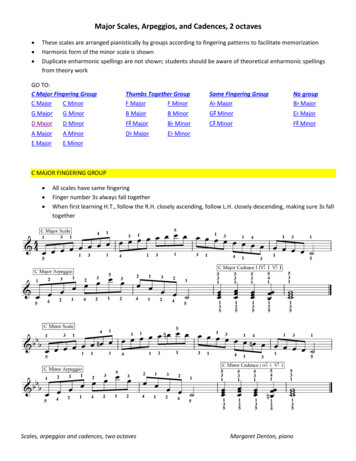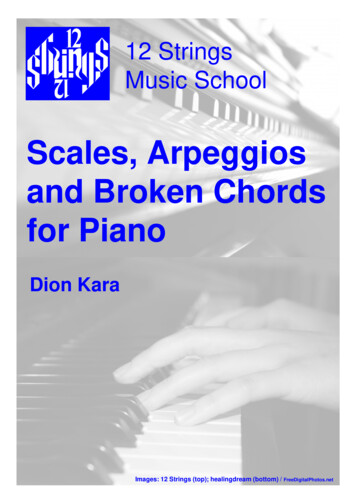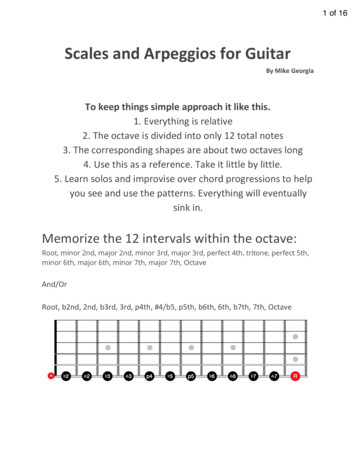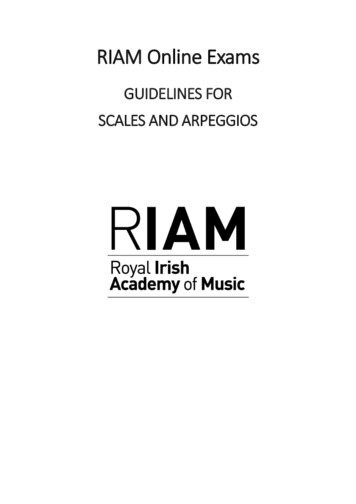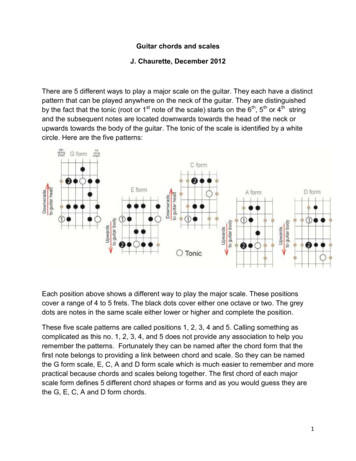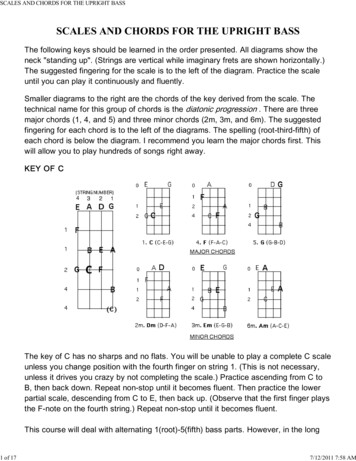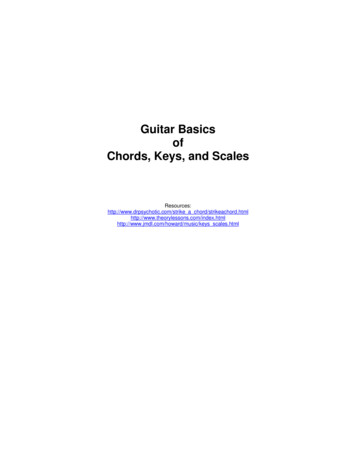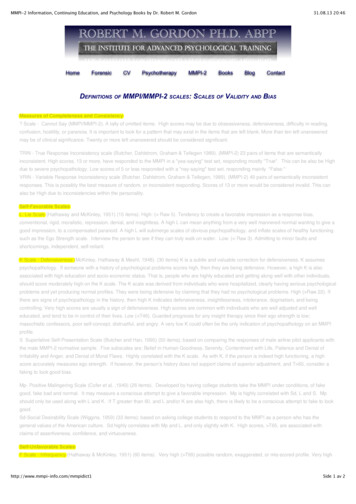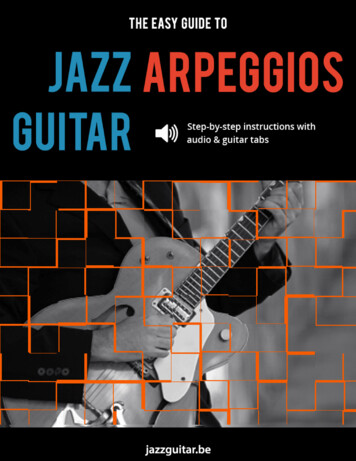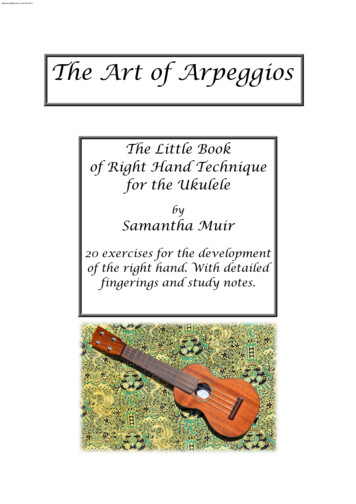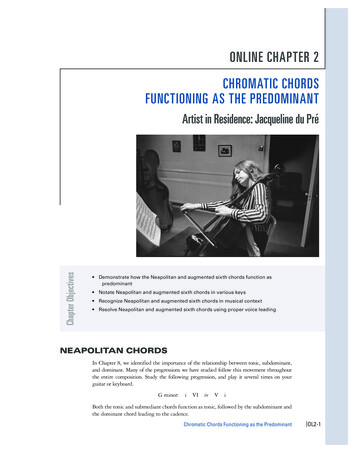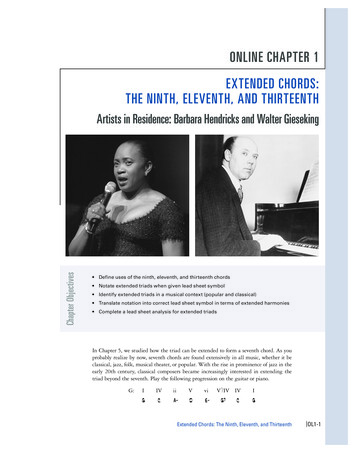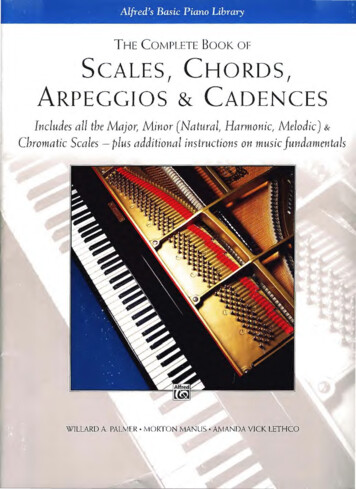
Transcription
IAlfred s BasicPiano LibraryThe Complete Book ofScales, Chords,Arpeggios & CadencesMinorIncludes all the Major,Chromatic Scales— plus[Natural, Harmonic, Melodic]&additional instructions on music fundamentalsWILLARD A. PALMFR MORTON MAN US AMANITA VI CK LETHCO
Major Keys, Minor KeysAround the& Key SignaturesCircle of 5thsBeginningwitliC and movingCircle of 5ths, the order ofBeginning withCIRCLEkeysOF 5thsC andcinFThe orderinKEYSIGNATUREaI'SHARPSC#GlE\ AtdI'occurDlwhich FLATS occurB RELATIVEBEF#moving counter-clockwise, the orderbI whichFtMINOR KEYis:is;The orderMAJOR KEYkeysD AC Gclockwise around theSHARPS OR FLATSElINdfKEY SIGNATUREMa'\orAGMajorE MinorittF D MajorB Minor2jt'sF ctAMajorFjtMinorF#ctGtE MajorCjlMinor4rsF cjtGlDtB MajorGttMinor5#'sc G«D AtMajorD# Minor6#'sFitctGtDtAtEtCH MajorAH MinorFtcttGtDtAtEtF MajorD MinorFjtNojt's,no ksUBl'MajorGMinor2\ 'sBi'MajorC Minor3\ 'sBl'At*MajorF Minor4\?'sB ElAkDtD\ MajorBi MinorB E\ AtDlG\ MajorE\}Minoret'sB EbAtCi MajoraI?Minor7ksB bI is:F\?CMinoris:Bitkey signaturesGtDtcl key signaturesinAltinGI'BtAtAtDtGtGtClGtC\ Ftof
Alfred s BasicPiano LibraryThe Complete Book ofScales, Chords,Arpeggios & CadencesMinor [Natural Harmonic, Melodic] &Includes all the Major,Chromatic ScalesWILLARDHowPartAnA.additional instructions on music fundamentalsPALMER MORTON MANUS AMANDA VICK LETHCO OrganizedIs1explanation that leads to the understanding of the fundamentals of major and minor scales, chords,arpeggios and cadencesisdiscussed insomedetail.Also includedisa clear explanation of scaledegrees and a two-page guide to fingering the scales and arpeggios. Pagts 4—i7Part 2The Major Scales: The keyPartofC plus the sharp keys in key signaturesequence. Pages48-333The MajorScales.-TheScales:The keyofScales:Thekeysflatkeysinkey signature sequence. Pages 34-47Pari 4The MinorA minor plus the sharp keysinkey signature sequence. Pages 48-63Part 5The Minorflatinkey signature sequence. Pages 64-77Part 6The ChromaticScales: Pages 78-79Part 7Enrichment Options: These added options are designed to further develop musicianship. Theysuggest anumberof additionalshould be practicedinways thescalesand chordsin parts2-5 may be played. Some of the optionsevery key being studied. Pages 80-89mAlfredCopyright MCMXCIV by Alfred Publishing Co.,All rights reserved.\/cr)kThis Book— plusdesign: MarthaWidmannAcdproduction: Bruce ColdcsEngelbartPrintedinUSA.Inc,
""7 don'tIlike to practice,play scales, slowly.neverdoneI'vetiave.this allBut whenmy life."""do get started at the piano, for the first 10 minutessounds you make. The sound of each toneyou. It will give you energy.IListen to thegenerate a response"inwillVan Cliburn"Do you askme how good a player you may become? Thentellme how much you practicethe scales.Carl Czerny7 consider the practice of scales important not onlyfor the fingers, but also for the discipline of thethe feeling of tonality (key), understanding of intervals,and the comprehensionof the totalear with regardcompasstoof the piano.Josef Hofmannhand and passing the hand overand arpeggios indispensable."Give special study to passing the thumb under theThismakesthe practice of scalesthe thumb.Jan Paderewski"Scales should never be dryIfyou are not interestedinthem, work with themuntilyou do become interestedinthem.Artur Rubinstein7 believematter of insisting upon a thorough technical knowledge, particularly scale playing,thisThe mereabilityisa veryvitalone.to play a few pieces does not constitute musical proficiency."Sergei Rachmaninoff"You must diligently practiceRobertThe importanceof scalesand arpeggios,allscales.Schumannparticularly with regard to the pianist's ability to perform,cannot be over-estimated. To trace the development of the major and minor scales through the history of music would requiremany pages,butwe do knowhadthat these scalestheir origins in thesystemofmodesthatwas developedinancient Greek music and music of the Church.Inancient Greece, certain musical tribes used afour).wasOnThelyre,the building(tetra meaningand were called a tetrachord. Thisa four-stringed harp called the tetrachordonencompassed by this instrument constituted ablock that was to become the basis for our modernfour tonesperfect 4th,scales.If we play a tetrachordonD,EIfwebeginningand F.begin a second tetrachord on G, we have the notes G, A,C, we have the notes C,B and C. The last C of this tetrachord is exactly one octave higher than the low C of the first tetrachord. These twotetrachords, played in succession, make an eight-note scale in the Ionian mode, which we now know as a majorscale. If we use the same tones beginning on the 6th note of the combined two tetrachords, we get the notes A, B,C, D, E, F, G and A. These notes constitute the Aeolian mode, which is also known as our natural minor scale.the keyboard, a tetrachord consists of a whole step, a whole step and a half step.The Greek philosopher Pythagorus (around 500 BC)iscredited with the discovery of the numerical ratios corre-With an instrument known as a monochord, consisting ofover a long sounding-board, Pythagorus found that by dividing the string into 2 equal parts,vibrated, would give a tone exactly one octave above the natural tone of the whole string. Byspondingto the principal intervals of the musical scale.oneonewhenstring stretchedpart,sounding 2/3a 5th above the natural tone would be produced. By sounda 4th would be produced. In similar manner, the ratios of all theof the length of the string, the interval ofing 3/4 of the length of the string, the interval ofnotes of the scale were discovered.of stringed and keyboard instruments, our modern major and minor scales were develassociated with all of the ancient and modern tunings were ultimately derived.temperamentsvariousandtheoped,With the ongoing evolution
Part 4PartiTetrachords4Building Major Scales5Triads6Triads:The 2ndInversionThe Primary TriadsinMajor KeysThe V7 ChordMinor Scales—Sharp KeysKeyofA Minor48KeyofE Minor50KeyofB Minor52KeyofFttMinor54Keyof CttMinor56Keyof GttMinor58KeyofDttMinor60Keyof AltMinor62789Scale Degrees10Arpeggios11Building Minor Scales12Part 5More About3rds, 5thsThe Primary TriadsThe DiminishedGuide7thin— Flat Keysand Triads13Minor eyofF Minor70Keyof B Minor72KeyofEl?Minor74ofAl?Minor76Chordto FingeringPart 2Major Scales— Sharp KeysMinor ScalesC Major18ofGMajor20KeyKeyofD Major22Part 6KeyofAMajor24Chromatic ScalesKeyofE Major26Part 7KeyofB ichment OptionsHarmonizing the Scales80Blocked Scales, Accelerating Scales81Expanding Scales No.821,No. 2PartsScalesMajor Scales— Flat KeysinDouble Thirds, Double Sixths,and OctavesKeyKeyof FofMajorBl?Major3484Broken Triads8538ofKeyofAl Major40Keyof DbMajor42KeyofG Major44Keyof Cl Major46MajorScales—The Grand Form36KeyeI?83Triad Chain,Cadences86Triads (Block and Broken)87Major Scale and Arpeggio Fingering Chart88Harmonic Minor Scale andArpeggio Fingering Chart89
amThe wordtetrameansfour.ATETRACHORDWHOLEA HALF STEPisisa series ofSTEP,WHOLEFOUR NOTESSTEP,having a pattern ofHALF STEPA WHOLE STEP is equto 2 HALF STEPS withONE KEY BETWEE the distancefrom any key to the very nextkey up or down, black or white,withNO KEY BETWEEN.DiiiiThe notes of a tetrachordmust be in alphabetical order!WHO!. EWHOLESTEPSTbPHAlFSTEP GC TetrachordThey must also havethis pattern!TetrachordMWHOLEWHOLEWHOLEWHOLEHALFHAL!A TetrachordD TetrachordiIWFiOLEWHOLEWHOLEHALFWHOLEHAlEB TetrachordE TetrachordfrjI1WHOLEWHOLE1HALF1WHOLEWHOLEHALE
TheMAJOR SCALEjoined by aWHOLEismadeofTWO TETRACHORDSSTEP.The C Major ScaleKEY-NOTEmIWHOLEKEY-NOTESTEPIis UO 'dorMAJORSCALE.0Therein ttieI?L1St2nd TetrachordTetrachordEach scale begins and ends on the noteof thesame name asthat of the scale, called theKEY NOTE.The G Major ScaleWHOLESTEP*r/7ere/sONEit(Fjj)intheG MAJOR SCALE.2nd Tetrachord1st TetrachordThe D Major ScaleWHOLESTEPr/?ere areintheITWOIt's (Ftj, Cjt)D MAJOR SCALE.2nd Tetrachord1st TetrachordThe A Major ScaleVv'HOLESTEPThere arein2nd Tetrachord1st TetrachordIMPORTANT!The 2nd tetrachordofCisthe 1st tetrachord of G.The 2nd tetrachordofGisthe 1st tetrachord of D.The 2nd tetrachordofDisthe 1st tetrachord of A.The 2nd tetrachordofA isThis overlapping patternthe 1st tetrachord of E.willcontinue around the Circle of 5ths!theTHREE it's (Fjl, Oi G t)A MAJOR SCALE.
A IRiADISA 3-NOTE CHORD,THE THREE NOTES OF A TRIAD ARE:5th5th8OR THIS;3rdROOTTheROOTisthe note from which the triad getsitsname. TheROOT of a C3rdROOTtriad is C,TRIADS MAY BE BUILT ON ANY NOTE OF ANY SCALE.Root position triadsPlay withIn CRH535311etc.nTriads:The§1st InversionANY ROOT POSITION TRIAD MAY BE INVERTED BY MOVING THE ROOT TO THE TORROOTC E GbecomesEGGALL LETTER NAMES ARE THE SAME, BUT THE ROOTThis1ST INVERSION TRIADSPlay with RH. UsePlay the above with1!Niscalled theFIRST INVERSION.C2 5 on eachtriad.LH ONE OCTAVE LOWER. Use5 31on eachtriad.ISON TOP.n
ANY 1st INVERSION TRIAD MAY BE INVERTED AGAINBY MOVING THE LOWEST NOTE TO THE TOP.ROOTTT "H" ROOT E G C-e-becomesG C EALL LETTER NAMES ARE THE SAME, BUT THE ROOTThis2ND INVERSION TRIADSPlay with RH.Usecalled theIS INTHE MIDDLE.SECOND INVERSION.IN C,3 5 on each1Is triad.HitPlay the above withTriadsLHin AllXTONE OCTAVE LOWER. Use 521on eachtriad.PositionsROOT POSITION1stINVERSION2nd INVERSIONROOT POSITIONPLAY THE FOLLOWING:C MAJOR TRIADSiLH:11 11 3-3mfREMEMBER:Ifthe rootison the bottom, theIfthe rootison theIfthe rootis in tlietriad is intop, the triad is inmiddle, the triad1stis inROOT POSITION.INVERSION.2nd INVERSION.
The three most important triads in any key are thoseThese are called the PRIMARY TRIADS of the key.The chords areInthe key ofidentifiedC MAJOR,The Primary TriadsCtheinRomanby thenumerals,CHORDIV CHORDV CHORDII,builtIVon theand V(11st,,4th4 andtheC TRIAD.(4 chord) is theF TRIAD.(5 chord) is theGchord)(1isand 5th notesof the scale.5).TRIAD.C MajorGmXTIVCFIVChord ProgressionsWhen we changeWhenallfrom one chord to another,chords areinroot position, thewecall thisa"CHORD PROGRESSION."hand must leap from one chordto the nextwhenplaying theprimary triads.To make the chord progressions easier to play and soundpositions bymoving one or moreThe chordiSof the higherThe top noteplayedm ROOT POSITIONCiSbetter,V chords may be playedthe IV andinotherchord tones down an octave.of the IVmoveo down anThe 2 lop notes of the V chord aremoved down an octave;chordoctave:FIVII,IVand VtriadsinWhen a triad is not in root position, the ROOT isALWAYS the upper note of the interval of a 4th!C MAJOR. Theing positions are oftenusedforCfollow-smoothMajor Chord Progression withThis chord progressionisI,IVand V Chords.also called a cadence.progressions.cFGc165551IVIVGCF— 2 0
—Inmanypieces aCHORDV7isTo make a V7 chord, a note anV7builtused insteadinterval ofon the 5th note 2ofa V TRIAD.a 7th above theol therootisaddedto theVtriad.C SCALE.7th5th3rdrootoo'{"iTRIAD4\7To have a smoother and easier progression with the The The 3rd5th (D)(B)isIandIV triads:omitted.and 7th(F)aremoved down anoctave.V7When a 7th chord is not in root position, the ROOTis ALWAYS the upper note of the interval of a 2nd!The Primary ChordsCHORDSThe three PRIMARYoareinnowC MajorI,IVand V7."V7IVI,IVand V7 chordsinC MAJOR. Thefol-lowing positions are often used for smootherCMajor Chord Progression withThis chord progressionisI,also calledIVa cadence.progressions.CF1: i 5IIVG7FG7IVV72-5— V7and V7 Chords.
The tonesTHEa scale are alsoofcalled thedegreesMOST fMPORTAMT SCALE DEGREES:3The key-notesame name as(the tone of the(or steps) of the scale.TONIC,the scale)Each scale degree has a name.DOMINANT and SUBDOMINANTiscalled theTONIC.Itisthe lowestand highest toneof the scale.The tone a5thABOVEThe tone a5thBELOW the tonicthe tonicisDOMINANT.called theiscalled theSUBDOMINANT.,rsUB means "below" or "under" (SUBmarine, SLIBway)!EACH SCALE DEGREE IS ALSO NUMBERED WITH A ROMAN NUMERAL WHICHPOSITION IN THE SCALE:TONIC DOMINANT V, SUBDOMINANT IV.ISDETERMINED BYITSI,Important!itistheThe causeIVofitspositionthe scale.inBELOW the tonic as the dominant is ABOVE the tonic!below the dominant. See bottom musicItisItcalled "subdominant"NOT calledisbecause"subdominant"staff.MORE SCALE DEGREES: MEDIANT and SUBMEDIANTThe tone a 3rd degree ABOVESince the mediantisThe tone a 3rd degreeSUBMEDIANT.the tonic (midway between the tonic and the dominant)the 3rd degree of the scale,BELOW the tonicSince the submediantis(midway between theis NAL SCALE DEGREES: SUPERTONICthe scale,itisSUBTONIC. LeadingdoesNote:inRoman numeralgiven theThe tone a 2nd degreethe tonicgiven theisRoman numeralisaLatinword meaningand LEADINGcalled theiscalled theisitgiven thethe middle.""inMEDIANT.III.and the subdominant)tonicthe 6th degree of the scale,MediantThe tone a 2nd degree ABOVEitiscalled theRoman numeralVI.ITONESUPERTONIC.Since the supertonicisthe 2nd degree ofII.BELOW the tonic is called the LEADING TONE.toneThe leading tone is sometimes called themost often used since the note has a strong tendency to "lead" to the TONIC, asSince the leading tone is the 7th degree of the scale, it is given the Roman numeral VII.isan ascending scale.itThe SUPERTONIC is always a WHOLE STEP above the tonic.The LEADING TONE is always a HALF STEP below the tonic.You now know the namesTONICofSUPERTONICallthe scale degrees. ArrangedMEDIANTSUBDOMINANTinDOMINANTorder thenamesSUBMEDIANTare:LEADING TONETONICXLIXTIVIIVIIIIIBe sure to remember that the degree names were derived fromTONIC is taken as the center tone:SUBDOMINANTSUBMEDIANT,LEADING TONETONICVIIthe following LVIIIIIIIwhich theo
The word ARPEGGIO comes from theplaying the notes of a chordinItalianarpeggiare, whichmeans"toplay upon a harp." This refers toa broken fashion, one after another, as one doeswhenplaying a harp.Arpeggios may be made from any chord. They may appear as simple broke
Parti Tetrachords 4 BuildingMajorScales 5 Triads 6 Triads:The2ndInversion 7 ThePrimaryTriadsinMajorKeys 8 TheV7Chord 9 ScaleDegrees 10 Arpeggios 11 BuildingMinorScales 12 MoreAbout3rds,5thsandTriads 13 ThePrimaryTriadsinMinorKeys 14 TheDiminished7thChord 15 GuidetoFingering 16 Part2 MajorScales—SharpKeys KeyofCMajor 18 KeyofGMajor 20 KeyofDMajor
